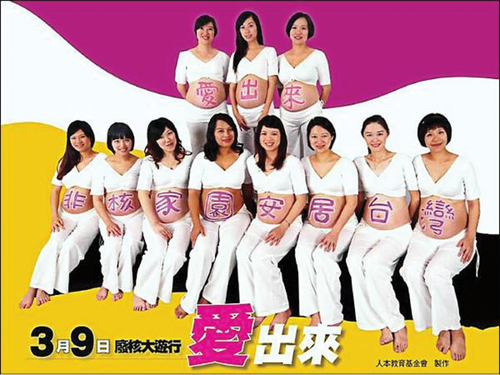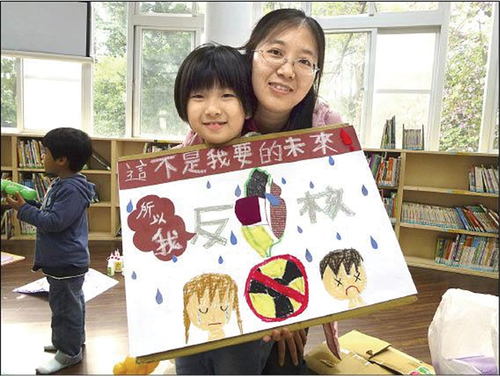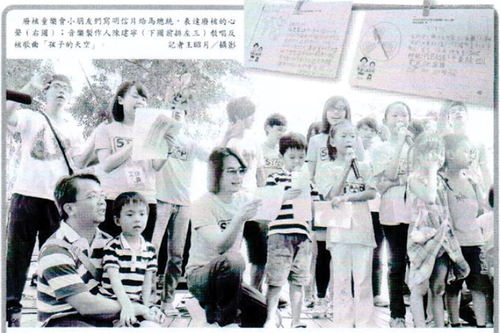ABSTRACT
Environmental Sociology has addressed gender, racial, and class dynamics within environmental movements, but the involvement of children, particularly in East Asia, remains under-researched. This article examines the representations of children in the news articles of Taiwanese anti-nuclear movements. With critical discourse analysis, the study examines 154 newspaper articles from two major newspapers published between 1987 and 2019. This article characterizes the representations of children in the news in three types: as slogans, as silent participants, and as defenders of rights. The paper shows that children have been reported in the news articles since the inception of the anti-nuclear movements, but their opinions were only recently reported. Dismissing children’s voices in the news articles could be related to undermining children’s capacity and agency to form views. The shifting representations of children in the news articles symbolize evolving power relations between children and adults, which are fluid, dynamic, and diverse rather than static. This article calls for a reflection on how children are represented in mass media and how the representations reveal the underlying presumption of children by adults.
Introduction
The involvement and roles of children in environmental movements in Asia remain largely unexplored (Hirsch and Warren Citation1998; Jobin, Ho, and Hsiao Citation2021; Kalland and Persoon Citation1999; Lee and So Citation1999). For instance, the existing literature in Taiwan’s environmental sociology does not adequately discuss children’s participation, creating an impression of their absence. However, historical photographs and certain previous studies can glean evidence of children’s involvement in Taiwan’s environmental movements (Weller and Hsiao Citation1999). This suggests that the issue is not the absence of children in environmental movements but rather the neglect and marginalization of children in research. Given children’s high vulnerability to environmental hazards and their status as stakeholders in environmental issues from an intergenerational justice perspective, the role of children warrants more attention (Fushiki Citation2013; Tremmel Citation2009). Despite this, the environmental activism of young people has been overlooked in most studies on environmental movements until recent times (Cele and van der Burgt Citation2016; Doyle and MacGregor Citation2013; Kallio and Hakli Citation2011; Karlsson Citation2018; Lee and So Citation1999).
Most environmental studies involving children focus primarily on environmental education, attitudes, and environmentalism within the home environment. This approach has limited our perception of children, often portraying them as passive recipients in a private sphere (Gentina and Muratore Citation2012; Karpudewan, Roth, and Abdullah Citation2015; Larsson, Andersson, and Osbeck Citation2010; Rousell and Cutter-Mackenzie-Knowles Citation2020). However, it is important to acknowledge that young individuals have actively participated in various environmental and social movements, contributing significantly to societal change (Bettencourt Citation2020; Collura et al. Citation2019). For instance, global climate strikes have been pivotal in youth-led environmental movements. These strikes not only mobilized individuals on an unprecedented scale but also had a significant political impact, emphasizing the need to address intergenerational conflicts related to climate change (Boulianne, Lalancette, and Ilkiw Citation2020; Holmberg and Alvinius Citation2020; Molder et al. Citation2022; Svensson and Wahlström Citation2023). Also, the movements of working children and adolescents (NATs) in Latin America have actively contested traditional paternalism and faced formidable political challenges from international organizations that neglect the rights to work among children needing financial independence (Liebel Citation2007; Liebel and Invernizzi Citation2019). Studying children’s involvement in environmental and social movements sheds light on intergenerational relationships and the oppressions that children face (Rodgers Citation2020). For example, focusing on the agency and rights of the child, Diane Rodgers (Citation2020) has classified children’s participation in social movements into three categories: strategic participants, participants by default, and active participants.
Sociologists in childhood studies have argued that children, as a distinct social group, have been largely overlooked and marginalized within mainstream sociology, including environmental sociology. Historically, sociological discussions concerning children have primarily revolved around socialization, with children are depicted as passive subjects needing rescue or education rather than as active participants advocating for their rights (Nyland Citation1995). Their lack of civil and political rights is often justified by their perceived immaturity (Mayall Citation1998). Scholars in the sociology of childhood advocate a shift in epistemological understanding of children and their relationships with other social groups by acknowledging children’s agency (Fine Citation2008; Wall Citation2022)..
Bell (Citation2010) posits that ‘adultism’ – behaviours and attitudes predicated on the belief that adults are superior to young people and have the right to act upon them without consent – marginalize young people based on their age, competence, knowledge, and experience. Social institutions, laws, and customs perpetuate this mistreatment. Adultism continues the narrative that credibility and the capacity for reason are exclusive to adults, whereas children are regarded as less capable and passive recipients of knowledge and actions. The widespread prevalence of adultism results in the systematic discrimination and oppression of children, effectively silencing them (Peters and Johansson Citation2012). The arguments presented by critical disability studies, which posit that individuals possess different abilities rather than fewer abilities, enhance our understanding of children as individuals with abilities that differ from those of adults. Childhood sociologists perceive children as experts in their daily experiences and as social actors who participate in interactions that shape and reshape social order.
Documentary analysis of childhood provides a lens through which we can examine the portrayal of children, which mirrors adults’ perceptions of children during a specific time. Philippe Ariès, a French historian, examined family paintings from the medieval era and argued that the concept of childhood did not emerge until recent times, indicating that child-adult relationships have evolved over time (Ariès Citation1962). Historian Ping-Chen Hsiung, who researched the representations of children in books and paintings in late imperial China, discovered that documents about children were scarcely created by children. Instead, she found an abundance of normative and adult-centric documents written by adults to educate and discipline children to respect their elders, uphold moral standards, be diligent in their studies, and accept severe punishment (Hsiung Citation1994, Citation2000).
Media content creates a public image of concepts, events, situations, behaviors or persons based on attributes imputed to them, directly or indirectly, intentionally or subconsciously. For example, Kacmarcik-Maduna (Citation2018) pointed out that in the media content in Bosnia and Herzegovina, children take up a tiny portion of space and time, indicating their marginal social status. Also, the topics they are covered classify them as fun ‘social topics’ and distance them from serious political and economic issues. Kaziaj (Citation2016) coined the term ‘adult gaze’ to describe the construction of news content as a reinforcement of adults’ perspectives on children, through the analysis of the portrayal of children in Albanian television news. The results showed that children are portrayed in limited roles as objects of emotional appeal, victims or performers. Also, the news related to children tends to focus the story around an adult figure, giving the adult’s views on the issue being discussed, which points to unequal power relations between children and adults. The ‘adult gaze’ reflects the take-for-granted presumptions of children among adults, including media workers, parents, and even experts. Different portrayals of children reveal various presumptions of children, which would have an impact on societal perception of a child, as a victim who is unable to form their opinion but to receive support, or a rights holder who plays an active role in policy-making (Alexander and Coveney Citation2013; Nichols Citation2002; Shin Citation2019). Therefore, conducting critical discourse analysis of the representations of children in newspaper articles enables us to explore the ways in which children are viewed, the underlying assumptions of children, and the generational relationships depicted in them.
Anti-nuclear movements in Taiwan
The anti-nuclear movement in Taiwan, which began in 1987 following the cessation of martial law, is the longest-running environmental movement in the country. Previous studies have explored the anti-nuclear movements in Taiwan from various perspectives, including politics, gender, culture, indigenous people, and the impact of the Fukushima nuclear disaster (Chin Citation2012; Ho Citation2003; Liang Citation2015; Wei Citation2016; Weller and Hsiao Citation1999). Moreover, research has documented Taiwanese youth’s engagement with environmental movements against climate change and air pollution (Chang Citation2022; Chiu Citation2018; Liao and Chang Citation2021). Weller and Hsiao (Citation1999) noted that the welfare of future generations was a concern raised by local environmentalists in Taiwan. However, their analysis focused primarily on cultural and gender issues rather than children. The role of children in anti-nuclear movements remains largely unexplored and undefined. Nevertheless, archival photos and articles suggest that children did participate in these movements. The nature of children’s participation and their roles within the anti-nuclear movement remain unclear.
This article seeks to investigate the representations of children in the news articles of anti-nuclear movements and the ideologies of children behind the representations. This study employs a social structural approach, categorizing individuals as ‘children’ and ‘adults’ to examine power dynamics, drawing parallels to other social structures such as class and gender (James, Jenks, and Prout Citation1998; Qvortrup et al. Citation2009). It operates under the premise that children, by their shared experiences regarding rights, power, law, welfare access, and space, constitute a distinct social group separating from other generational cohorts (Olk Citation2009). Representation involves power relations and politics. This article documents the power meanings, as well as struggles, that children symbolize in the representations. This article poses the following research questions: How are children in this movement portrayed in the news? What meanings of children are demonstrated in the representations? By examining these questions through the lens of childhood sociology, this study aims to foster a connection between childhood studies and environmental sociology.
Methodology
This paper employs critical discourse analysis to examine the representations of children in anti-nuclear movements, as portrayed in news articles. Representation involves power relations and politics. This study selected two newspapers based on their circulation and political orientation. One is the United Daily News, a conservative newspaper with a pro-Kuomintang political party stance that supports nuclear power. The other is the Liberty Times, known for its liberal-leaning and support for the Democratic Progressive Party, which opposes nuclear power. The study anticipated that the Liberty Times would feature more articles on anti-nuclear movements than the United Daily News. The data collection spanned from 1987, marking the inception of the first anti-nuclear movement, until the end of 2019, as the government restricted mass gatherings due to the onset of the COVID-19 pandemic in 2020.
Articles were sourced from digital archives in a two-step process. The initial step involved identifying news articles related to anti-nuclear movements. The subsequent step focused on pinpointing the coverage of children within these anti-nuclear movement articles. The search terms for the first step encompassed ‘nuclear power,’ ‘anti-nuclear power,’ ‘nuclear power plant,’ and ‘nuclear disaster.’ The term ‘children’ is defined in various ways, with some definitions based on age and others on intergenerational relationships. This study incorporated both these aspects. The search terms used in the second phase included ‘child,’ ‘kid,’ ‘student,’ ‘infant,’ ‘descendant,’ ‘offspring,’ ‘next generation,’ and ‘future generation.’ The analysis encompassed a total of 154 articles, with 85 published in the United Daily News and 69 in the Liberty Times.
After selecting articles, critical discourse analysis is used to examine the representations of children in the news content and images, and the power relations conveyed through these representations. Critical discourse analysis is concerned primarily with identifying the linguistic expressions of power relations within society. This method is used to expose and dissect the concealed and implicit power dynamics through the control of text (Cheek Citation2004; Deacon et al. Citation1999; Khan and MacEachen Citation2021; Mendes Citation2011). It examines the interconnectedness among three dimensions: the text itself, discourse practices (including production and reception), and the socio-cultural practices that envelop them (Fairclough Citation1995; Schrøder Citation2007). Critical discourse analysis illuminates our understanding of the presumption of children in the news contents and the power relations behind it. By analyzing the representations, this article focuses on the power relations between children and adults in the anti-nuclear movements, and that between children and journalists who produce these representations.
Reporting of children in anti-nuclear movements
The quantity of news articles about children reached its zenith during two distinct periods: 1987–1995 and 2011–2015, as illustrated in . These periods of heightened media attention coincided with two significant nuclear catastrophes: the Chernobyl disaster in 1986 and the Fukushima disaster in 2011.
Table 1. The number of new articles of anti-nuclear movements that reporting children from 1987 to 2019.
The first newspaper coverage of Taiwan’s anti-nuclear movement traced back to a protest on 26 April 1987, against the construction of the Fourth Nuclear Power Plant in Gongliao, New Taipei City. This protest, which marked the first anniversary of the Chernobyl disaster, signified the commencement of Taiwan’s first wave of anti-nuclear activism.
The anti-nuclear movements in Taiwan experienced a revival following the 2011 Fukushima disaster. Given Japan’s proximity to Taiwan, the nuclear catastrophe triggered widespread public fear about nuclear power safety and the potential for contamination during nuclear incidents. This renewed wave of anti-nuclear activism underscored the inherent dangers and risks associated with nuclear power and disasters (Chen Citation2011; Ho Citation2014). The movement reached its zenith in 2013, marked by an unprecedented scale of protest and a hunger strike in 2014, which ultimately led to the government’s decision to suspend the construction of the Fourth Nuclear Power Plant. Between these two periods of intense activism, the movement was quiet after the ascension to power of Shui-bian Chen, president of the Democratic Progressive Party, who temporarily halted the construction of the Fourth Nuclear Power Plant in 2000. The data gathered for this study also revealed a noticeable decrease in newspaper coverage of anti-nuclear movements and the involvement of children in these movements from 2001 to 2010.
The first documented instance of children’s involvement in anti-nuclear movements dates back to a protest led by the indigenous people of Lanyu, an island off the coast where plans were underway to construct a nuclear waste storage site on 25 April 1988. The protest was a march advocating for a clean and safe environment free from nuclear waste. The article indicated that around 2,000 individuals, including both parents and children, assembled to voice their views on nuclear power (United Daily News, 25 April 1988). They engaged in a hunger strike and marched in front of the Atomic Energy Council in Taipei, bearing slogans such as ‘I love Lanyu, no nuclear waste’ and ‘We want kids, not nukes.’ Thus, according to this article, children have been participating in anti-nuclear movements from the beginning.
This paper characterized the portrayals of children in newspapers as slogans, silent participants, and advocates for rights, which is discussed in the following sections.
Children as slogans: ‘we want kids, not nukes’
In the articles of anti-nuclear movements, the term ‘children’ is frequently associated with articles and images featuring slogans such as ‘We want kids, not nukes,’ ‘An environment free from nuclear disasters for the next generation,’ ‘Fight against nuclear power, save our descendants,’ and ‘The future we could not lose.’ The slogan ‘We want kids, not nukes’ was first reported in protests by indigenous people in Taipei in 1988. From 1991 onwards, children are reported along with ‘anti-nuclear moms’ from the Homemakers United Foundation, the earliest women’s environmental foundation in Taiwan, focusing on environmental education and promoting eco-friendly lifestyles. A news article titled ‘Anti-nuclear march led by baby soldiers’ featured a photo of women walking with their babies in baby carriages in the march (). The title is a metaphor for war against nuclear power, and children are pushed to the frontlines. There are also other new articles about women’s groups organizing anti-nuclear events for children, such as illustration book reading events (Liberty Times, March 4, 2013) and press conferences that protest against the construction of the Fourth Nuclear Power Plant on Children’s Day (Liberty Times, 3 April 2013).
Figure 1. The reporting of ‘baby soldiers’ related to the anti-nuclear march in 1999.
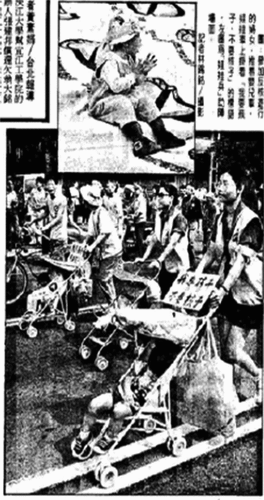
Of all the news articles included in this study, another emblematic image from Taiwan’s anti-nuclear movement is a poster featuring 11 pregnant women (). They posed together and had their belly painted with the words, ‘Walk out for love, a home free from nuclear, safe Taiwan,’ to call for fellow citizens to join the march in defence of Taiwan’s environment and children (Liberty Times, 7 March 2013). The message conveyed by these expectant mothers was the protection of the most vulnerable lives – the unborn – and future generations of Taiwan. These examples demonstrated that the portrayals of children are usually associated with mothers in new articles. These articles, however, highlight women’s voices in fighting to safeguard children. Children’s voices in these articles are missing or indirect, and their role is decorative.
In addition to be linked with mothers, children are sometimes reported in the interviews with fathers and grandparents who expressed that they participated in anti-nuclear marches for the sake of their children. For instance, a news article featured an interview with film director Cheng Yu-Chieh, who, despite not typically favoring marches as a form of protest, expressed his willingness to bring his children to such an event. He viewed it as a crucial chance for his children to understand the intergenerational injustice related to nuclear waste. He stated, ‘I am against nuclear power because of my children. They cannot enjoy the benefits of nuclear power but live with nuclear waste, which is an issue of generational injustice. Of course, I must let them know this’ (Liberty Times, 13 March 2015).
In other articles, older adults participating in the protest to urge the government to fulfill the responsibility to protect their well-being and that of future generations. For example, one article highlighted an 84-year-old grandmother from Gongliao District in New Taipei City, the proposed Fourth Nuclear Power Plant site. She had been an active participant in anti-nuclear demonstrations for 13 years. Despite a car accident that occurred on the route to a protest. Her concern for her descendants drove her steadfast commitment to the anti-nuclear cause. As quoted in the report, she stated, ‘I did it for my grandchildren, not for myself. I have more than 30 grandchildren’ (United Daily News, May 14, 2000).
These examples illustrate that the journalists reported various adults, including pregnant women, mothers, fathers, and grandparents, who have participated in anti-nuclear movements for the sake of children and future generations. The slogan ‘we want kids, not nukes’, however, represents a call from adults who are parents and grandparents instead of children themselves. These slogans portray children as objects rather than as active participants. In addition, the narratives in the news articles showed that despite adults advocating for a nuclear-free environment for and on behalf of children, this advocacy was irrespective of the presence or absence of children, such as the grandmother walked to fight for her descendants. In these campaigns, even children were positioned on the frontlines of the movement, and children were constructed as passive objects on the news.
While previous research has examined this phenomenon through the lens of gender and culture (Weller and Hsiao Citation1999), the anti-nuclear movement is neither solely a women’s movement nor a children’s movement. The demands made within these movements necessitate the involvement of both groups. Therefore, I propose that this phenomenon can be better understood from a generational perspective. It showcases an intergenerational relationship between parents and children, and between ancestors and descendants, within the context of anti-nuclear movements. This finding underscores the intergenerational ties between children and other generations. Prior studies on Canadian indigenous peoples have discussed the sacred status of children in traditional indigenous culture and how the responsibility of caring for them is shared by the extended family, making children the focal point and unifying element of the family (Pace-Crosschild Citation2018). Similarly, in Taiwanese culture, the continuation of family life is a primary concern. Children, being the future of families, bridge generations of activists in their collective fight against nuclear power in Taiwan.
Children as silent participants
Children participating in anti-nuclear movements were typically portrayed as silent activists in news coverage. Children are highlighted in article titles and images for two reasons. First, they are adorable and eye-catching when children participate in environmental movements or any kind of social movements. Second, children in the environmental protests form a sharp contrast because they are regarded as obedient to authorities in the private sphere instead of fighting in the public sphere. Nevertheless, their opinions and voices were notably missing from these reports, especially during the initial phase of the anti-nuclear movement. Of 154 articles that mentioned children in the anti-nuclear movement, only 10 included their viewpoints.
News articles frequently feature parents and children participating in anti-nuclear protests, but the voices quoted are typically those of the parents. For instance, one article quoted a mother who attended a rally with her five-month-old son, saying, ‘We want to teach children not to be indifferent. Attending the march and demanding a nuclear-free home is to show him he cares about himself and others’ (Liberty Times, 10 March 2013). The movement is regarded as a venue for social learning by parents.
Numerous news articles focused on journalists’ observations of young individuals rather than conducting direct interviews. For instance, the United Daily News covered an anti-nuclear protest on Lanyu Island, attended by thousands of islanders, including over 100 primary and secondary school students (United Daily News, 2 May 2002). The article stated, Hsieh Wen-lon, a Year-9 student in the Lanyu secondary school who sent an appeal letter to the president before, asked for a day off from his school to join the anti-nuclear protest. His small body was eye-catching in the crowd. As is typical in many news articles, children are often portrayed as noticeable and endearing, but their opinions are absent.
In some instances, the journalist interacted with the children without directly quoting them. A 1996 article highlighted an anti-nuclear march spearheaded by eight children, ages 4 to 10, carrying a banner that read, ‘For children, No nukes’ (). Children participate in the marches so often that anti-nuclear movements in Taiwan form a ‘parent-and-child team,’ which became a vital part of the anti-nuclear marches, alongside other groups such as nuclear power victims, celebrities, artists, politicians, and social associations. This arrangement, where children led the march followed by women with baby carriages, eventually became a standard element of anti-nuclear protests. The article noted a striking contrast between the children’s innocent smiles and the anti-nuclear issue. The news only reported that many children understood what anti-nuclear meant and why they were participating in the protest (United Daily News, 9 June 1996).
Figure 3. Children walked at the front of the anti-nuclear march.
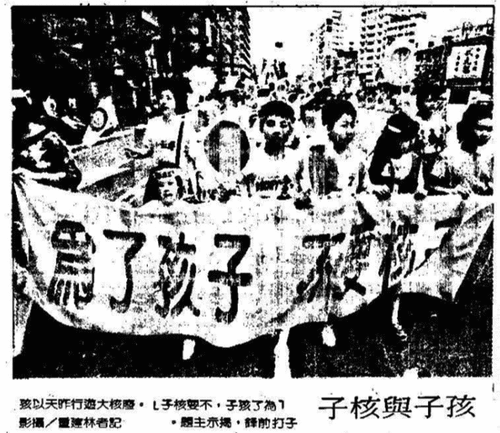
Children’s voices are often underrepresented, leading to uncertainty about their role in the movement. For instance, a news article reported a group of children, led by their mothers who were part of the Homemakers Foundation, chanting an anti-nuclear slogan: ‘I am afraid of a nuclear explosion. I wish to grow safely’ (Liberty Times, 10 March 2013). Even though the children participated in the chant alongside their parents, it remains challenging to discern whose voices they were, given that only the mothers were interviewed for the article. The journalist portrayed the children as ‘cute and innocent.’
The common practice of journalists portraying children as adorable while disregarding their agency and views results in a passive representation of children in news articles. This could be related to the fact that most children who participated with their parents are young children at preschool age who cannot express themselves sophisticatedly. Yet, this voiceless representation of children also happens among children who can actively express themselves, such as primary school and junior high school students. For example, one article titled ‘a 10-year-old child stand on the street againstnuclear power’ with his photo taken (Liberty times, 27 March 2014). With this title, the boy seemed to be the focus of this news, but the content is mainly the mother’s opinions, which challenged the safety of nuclear power and urged the government to take responsibility for guarding the next generation. The article only included one sentence in which the boys said, ‘We want a clean future, not a nuclear power plant.’ However, the words on the signboard he held asked President Ma Ying-jeou to step down, which is a political claim instead of an environmental one (). Therefore, it is unclear whether his family mobilized him.
Figure 4. Ten-year old boy standing on the street holding a signboard to ask the president to stand down.
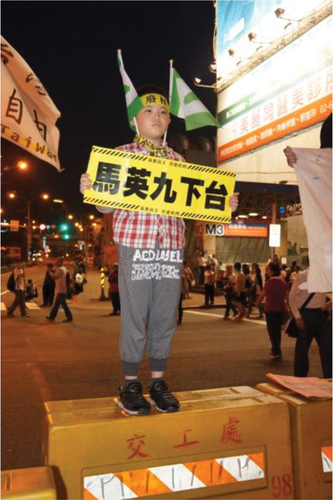
Such representations reflect adultism, a phenomenon where adults disregard or trivialize children’s opinions (Perry-Hazan Citation2016). Adults, including journalists, often overlook children’s ability to form opinions, typically interviewing adults instead. The culture of ‘children should be seen and not heard’ prevalent in Taiwan could hinder adults from seriously interviewing and listening to children. Consequently, children’s perspectives are omitted from news articles, leaving their subjectivity ambiguous. Adultism, however, is not exclusive to Taiwan; it is a widespread global issue. Perry-Hazan (Citation2016) demonstrated that when Israeli youth participate in policymaking, they are often not taken seriously by adults. While adults may find the youth ‘endearing,’ their responses can be patronizing or dismissive, further exemplifying adultism.
The marginalization of children within the anti-nuclear movement is evident in the lack of child-friendly or family-friendly considerations. Despite children’s participation in anti-nuclear marches since 1988, their needs are often neglected by organizers. For instance, a news article reported that a six-kilometer march proved too strenuous for many children, forcing their parents to carry or assist them (Liberty Times, 30 March 2013). This exemplifies how the movement, frequently characterized by long marches, poses challenges for young children and their parents, with adult organizers failing to account for these young activists’ special needs. Yet, children can be and have been mobilized within the movement.
Another article about protests in Lanyu highlighted how the Lanyu Anti-Nuclear Self-Help Society mobilized not only adults but also junior and primary school children, using their fear of nuclear waste as a protest theme. Like most other anti-nuclear marches, the community agreed to position the schoolchildren at the forefront of the march (United Daily News, 1 May 2002). This report portrays the students as passive participants subject to adult decision-making.
When parents involve their young children in environmental movements, public opinion often becomes polarized, especially in the event of conflicts. Although most anti-nuclear movements in Taiwan have been peaceful, sporadic conflicts have occurred. On 27 March 2014, a group of parents and children occupied a road overnight. The police used water cannons to disperse them by morning. One segment of public opinion criticized the parents for using their children as shields, effectively objectifying them. Conversely, others argued that the children’s perspective was clearer than that of politicians, emphasizing their agency. However, both viewpoints overlook the children’s opinions, demonstrating a form of adultism where children’s voices are neither sought nor respected before forming judgments. A different news report quoted a blog post that recorded a conversation with a six-year-old participant who expressed his wish for government officials to hear their voices against the nuclear power plant. The child learned to protect himself during the incident, and the adults assured him of their protection. These different articles demonstrated that adults often pose their perception of children’s opinions, neglecting children’s own opinions. It was until one article that included the child’s voice that his opinion was clear, which can avoid misinterpretation or misjudgment from adults.
Children as the defenders of rights
Children have participated in the anti-nuclear movement since the 1980s, but it wasn’t until the movement’s second wave that their voices were directly reported. The anti-unclear movement reached an unprecedented scale in 2013 when the government proposed a referendum on building a fourth nuclear power plant after the Fukushima nuclear accident. Anti-nuclear marches were held in most major Taiwanese cities. News reports indicated that many participants were under 30 years old, particularly students. One article quoted a 10-year-old girl alongside other young people aged 20 to 28, shown in . This girl expressed her concerns about nuclear waste and the potential for another disaster like Fukushima, stating, ‘I do not want another Fukushima accident. Nuclear power produces nuclear waste. If nuclear waste cannot be resolved, the world will become dirtier ‘(United Daily News, 10 March 2013).
Figure 5. A 10-year-old girl’s opinion was published along with those of other young people.
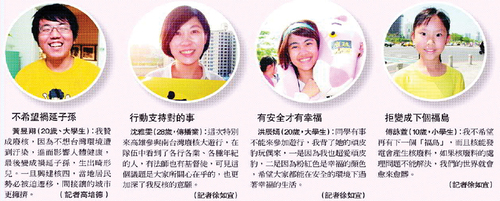
In another article, a high school student argued that the government’s proposed referendum was unjust because high school students do not have the right to vote. The article wrote:
Junior high school students YW Wu, CH Lee, and AJ Chen held their handpainted posters and said, ‘We are still young. We want a life without fear. We want the opportunity to fulfil future dreams, so we are against nuclear power. (Liberty Times, March 10, 2010)
One article featured a Year-6 Paiwan boy from Taitung dressed in traditional attire with his face painted white, symbolizing the potential consequences of continued nuclear power usage. He stated, ‘if we keep using nuclear power, our polluted face will look like this’ (). The stark white face symbolized sickness or death (United Daily News, 10 March 2013).
Figure 6. An indigenous boy and a pregnant woman who joined the anti-nuclear march.
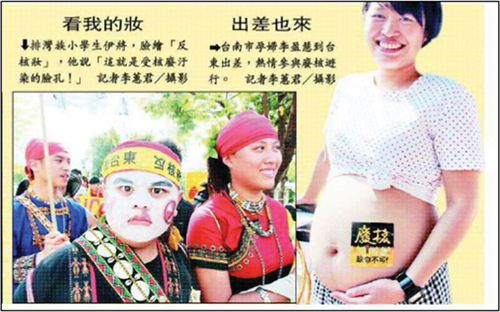
Another news reported that one girl voiced her stance via her anti-nuclear poster, stating, ‘Nuclear power is not the future I want, so I am against it‘ (see ) (Liberty Times, 4 March 2013). In , the girl is supported by her mother, illustrating a parent–child relationship where the child is the primary speaker, supported by her parents. This contrasts with earlier news reports where children were merely observed, and adults were the ones expressing their views.
Young people’s perspectives reveal that they are not immune to the effects of disasters and pollution, expressing concerns similar to those of adults. In today’s global society, pollution transcends national boundaries, and nuclear disasters in Japan impact the daily lives and emotions of children in Taiwan. For instance, the Taiwanese government imposed a ban on food imports from regions surrounding Fukushima in Japan in March 2011. Moreover, the leakage of radioactive water from Fukushima into the ocean has raised concerns. Consequently, Taiwanese children are not exempt from the potential risk of exposure to radioactivity. While children are eager to voice their opinions, the real question lies in whether adults allow them to do so and whether they genuinely listen to these young voices.
While anti-nuclear protests in Taiwan are predominantly adult-focused, the news documented a unique anti-nuclear music event for children on Children’s Day, 1 June 2013 (see ) (United Daily News, 2 June 2013). This was the first and, to date, the only anti-nuclear event designed specifically for children. The event featured several child-centered activities, including songs, handprint-making, and creating anti-nuclear postcards for the president. Two adults co-hosted the event with two children, empowering the children to express themselves. Even though the event’s coverage did not capture the children’s perspectives, the event’s structure indicated a shift in power relationships between child and adult activists, moving from an authoritarian dynamic to a more child-centered and child-friendly one.
Discussion
This article explores the representations of children in anti-nuclear movements in newspapers and the power relations behind them. The findings show that children have participated in these movements from early stages. Children are seen in titles and images of news articles but their opinions were reported after 2010s. The article characterizes the meanings of children’s representations in news reports into three distinct types: as slogans, as silent participants, and as advocates for rights.
When children are reported as a slogan ‘we want kids, not nukes’ in the newspapers, the informants in the news are mostly parents and grandparents who advocate for a ‘no nukes’ society for and on behalf of their children and future generations. Adults are the subject of the representations. Children are presented as the object of the message rather than its conveyors. In this news, adult activists fight for their descendants rather than for their interests. Previous studies have linked these adults’ behavior to the Taiwanese culture of filial piety and the importance of preserving the family lineage (Weller and Hsiao Citation1999). This study, however, shifts the focus to intergenerational relationships in the representation, highlighting the pivotal role the younger generation plays in motivating their elders to fight for environmental causes. This pattern, where children serve as a link between their family and culture, is also observed among Canadian indigenous communities and is considered sacred (Pace-Crosschild Citation2018). In the framework of ‘children as slogans’, children serve as a unifying factor, prompting individuals across generations to protest for a safer environment for the generations now and those to come. However, the presence or absence of children was not crucial in this framework.
When children are presented as silent participants in the news, children are visible but not vocally present in the news reports of the anti-nuclear movement for an extended period. Their voices and agency are missing or ambiguous in the news content. The results showed that children were frequently positioned at the forefront of marches, leading processions and carrying banners. Although children were visually present, it was the adults’ viewpoints were reported in the news articles. The result echoes Kaziaj’s study of Albanian news that children are reported around an adult figure and the adult’s views on the issue were discussed, and the voices of children are missing in the news. The imbalanced reporting reveals unequal power relations between children and adults. The ‘adult gaze’ reinforces the perspectives of adults on children. This practice effectively sidelines children’s voices from public discourses. Without children’s voices, it becomes challenging to discern whether their participation in the movement is self-motivated. Also, the marginalization of children’s voices in the news is a sign of neglecting children’s capacity to form opinions, which might be caused by adultism that posits the belief that adults are superior to children. In adultism, adults’ opinions are more valid and important than children’s opinions.
During the second wave of Taiwan’s anti-nuclear movement, notably during the 2013 anti-nuclear marches, newspapers began to depict children as advocates for their own rights. The news articles shared the children’s perspectives while their parents continued to oppose nuclear power on their behalf. Nuclear power is an issue of intergenerational injustice, as defined by Tremmel (Citation2009), implying that it has cross-generational impacts. The news reported children’s concern about the potential threats of nuclear waste and nuclear accidents to their future. They argued that they were forced to bear the risks associated with nuclear waste, while previous generations reaped the benefits of nuclear power, leading to their opposition. The children’s viewpoints highlighted intergenerational injustices of nuclear power, which is different from the claims of a safe environment made by adults. They were voicing their own rights and defending them. Featuring the children’s perspectives that emphasizing intergenerational justice enriches the diversity of public discourses on anti-nuclear movements, which is advantageous not only to children but also to environmental movements.
The second wave of the movement saw a significant presence of children’s direct voices in news articles, suggesting a slight improvement in newspaper representation of children that often dismisses children’s viewpoints. However, the representation of children as slogans and silent participants did not disappear in the news articles. These representations remain in the news articles. Hence, power relations between children and adults were fluid, dynamic, diverse, and contested rather than static. By analyzing children’s representations in anti-nuclear movements on newspapers, this paper demonstrated the portrayals of children have shifted. The ways that the media portrays children may shape public understanding of children. Therefore, this article calls for a reflection on how children are represented in mass media, and how the representations reveal the underlying presumption of children by adults. There is still room for improvement in recognizing children’s agency and facilitating their voices being presented in public media, which can be achieved by enhancing adults’ awareness of children’s agency and voices.
Children are not exempt from the disasters brought about by nuclear accidents and climate change. Despite being significant stakeholders in environmental issues, their largely overlooked in the media representation, as demonstrated in this paper.
This study does have certain limitations. It relies on an analysis of newspaper articles, in which children’s representations are created by journalists. The children featured in these articles are primarily young ones who participated in marches alongside their parents, with the parents being the ones interviewed. Junior and senior high school students are underrepresented, making it challenging to determine whether this is due to journalists’ selection bias or these students’ infrequent participation in the marches. Furthermore, this study is based on journalists’ representations of children in news articles. Previous U.S. studies have indicated that pervasive adultism often leaves students feeling disrespected despite their involvement in environmental education programs (Ceaser Citation2014). Hence, future research could use interviews and observations to capture better children’s experiences and opinions in environmental movements.
Conclusion
This article examines the representations of children in newspaper coverage, aiming to fill a gap in environmental sociology, particularly in the context of Taiwan. Children were absent in the literature of environmental movements in Taiwan. This paper explores the representations of children in anti-nuclear movements in news content. The data showed that children have been reported in the anti-nuclear movements since 1988. Hence, children were not absent from anti-nuclear movements in Taiwan; yet, they are absent in existing literature of environmental research.
The study classified children’s representation into three types. First, when children were represented as slogans, adults were the subjects and children were presented as objects of the message rather than as conveyors. When children are presented as silent participants, they are usually seen but not heard. It was not until the 2010s that the newspaper depicted children as rights defenders and reported their voices and opinions directly. The changing representations of children indicate shifting perspectives of children from adults in general. This paper showed that direct interviews with children highlighted their opinions on generational justice, which were missing in adults’ opinions. Children’s perspectives can enrich the discourses of anti-nuclear movements.
By analyzing the representation of children in newspapers, this article calls for a reflection on how children are represented in mass media, and how the representations reveal the underlying presumption of children by adults. Drawing on data from newspaper reports of anti-nuclear movements Taiwan, this paper sheds light on our understanding of children representations in media and the power relations behind them.
Disclosure statement
No potential conflict of interest was reported by the author(s).
Additional information
Funding
Notes on contributors
Hung-Chieh Chang
Hung-Chieh Chang is an Assistant Professor of Public Health with a shared appointment in the Institute of Health Policy and Management at the National Taiwan University. Her research interests are in child health, environmental health disparities, environmental governance, and intergenerational justice.
References
- Alexander, S. A., and J. Coveney. 2013. “A Critical Discourse Analysis of Canadian and Australian Public Health Recommendations Promoting Physical Activity to Children.” Health Sociology Review 22 (4): 353–364. https://doi.org/10.5172/hesr.2013.22.4.353.
- Ariès, P. 1962. Centuries of Childhood: A Social History of Family Life. New York: Knopf.
- Bell, J. 2010. “Understanding Adultism: A Key to Developing Positive Youth-Adult Relationships.” In Readings for Diversity and Social Justice, edited by M. Adams, W. J. Blumenfeld, C. Castañeda, H. W. Hackman, M. L. Peters, and X. Zúñiga, 540–546. 2nd ed. New York, NY: Routledge.
- Bettencourt, G. M. 2020. “Embracing Problems, Processes, and Contact Zones: Using Youth Participatory Action Research to Challenge Adultism.” Action Research 18 (2): 153–170. https://doi.org/10.1177/1476750318789475.
- Boulianne, S., M. Lalancette, and D. Ilkiw. 2020. “‘School Strike 4 Climate’: Social Media and the International Youth Protest on Climate Change.” Media and Communication 8 (2): 208–218. https://doi.org/10.17645/mac.v8i2.2768.
- Ceaser, D. 2014. “Unlearning Adultism at Green Shoots: A Reflexive Ethnographic Analysis of Age Inequality within an Environmental Education Programme.” Ethnography and Education 9 (2): 167–181. https://doi.org/10.1080/17457823.2013.841083.
- Cele, S., and D. van der Burgt. 2016. “Children’s Embodied Politics of Exclusion and Belonging in Public Space.” In Politics, Citizenship and Rights. Geographies of Children and Young People, edited by K. Kallio, S. Mills, and T. Skelton, 189–205. Singapore: Springer.
- Chang, H.-C. 2022. “Climate Strike or Not? Intersectionality of Age and Culture Encountered by Young Climate Activists in Taiwan.” Childhood-A Global Journal of Child Research 29 (1): 7–23. https://doi.org/10.1177/09075682221074869.
- Cheek, J. 2004. “At the Margins? Discourse Analysis and Qualitative Research.” Qualitative Health Research 14 (8): 1140–1150. https://doi.org/10.1177/1049732304266820.
- Chen, D. S. 2011. “Taiwan’s Antinuclear Movement in the Wake of the Fukushima Disaster, Viewed from an STS Perspective.” East Asian Science, Technology & Society: An International Journal 5 (4): 567–572. https://doi.org/10.1215/18752160-1465683.
- Chin, L.-L. 2012. “Yes or No? Deliberative Democracy on Taiwan’s Nuclear Waste Policy and the Development of an Aboriginal Tribe.” Taiwan Journal of Indigenous Studies 5 (2): 1–39. https://doi.org/10.29910/TJIS.201206.0001.
- Chiu, H.-M. 2018. “The Classroom Under the Chimney: The Environmental Activism.” In Scientific Social Human 3, edited by K.-Y. Lin, W.-Y. Lin, and T.-D. Lin, 194–205. Hsin-Chu: National Chiao Tung University Press.
- Collura, J. J., H. Raffle, A. L. Collins, and H. Kennedy. 2019. “Creating Spaces for Young People to Collaborate to Create Community Change: Ohio’s Youth-Led Initiative.” Health Education & Behavior 46 (1_suppl): 44S–52S. https://doi.org/10.1177/1090198119853571.
- Deacon, D., M. Pickering, P. Golding, and G. Murdock. 1999. Researching Communications: A Practical Guide to Methods in Media and Cultural Analysis. London: Arnold.
- Doyle, T., and S. MacGregor. 2013. Environmental Movements Around the World: Shades of Green in Politics and Culture. Santa Barbara, California: Praeger.
- Fairclough, N. 1995. Critical Discourse Analysis: The Critical Study of Language. London: Longman.
- Fine, M. 2008. “An Epilogue, of Sorts.” In Revolutionizing Education: Youth Participatory Action Research in Motion, edited by J. Cammarota and M. Fine, 213–234. New York: Routledge.
- Fushiki, S. 2013. “Radiation Hazards in Children – Lessons from Chernobyl, Three Mile Island and Fukushima.” Brain and Development 35 (3): 220–227. https://doi.org/10.1016/j.braindev.2012.09.004.
- Gentina, E., and I. Muratore. 2012. “Environmentalism at Home: The Process of Ecological Resocialization by Teenagers.” Journal of Consumer Behaviour 11 (2): 162–169. https://doi.org/10.1002/cb.373.
- Hirsch, P., and C. Warren, eds. 1998. The Politics of Environment in Southeast Asia. London: Routledge.
- Ho, M.-S. 2003. “The Politics of Anti-Nuclear Protest in Taiwan: A Case of Party-Dependent Movement (1980–2000).” Modern Asian Studies 37 (3): 683–708. https://doi.org/10.1017/S0026749X03003068.
- Ho, M.-S. 2014. “The Fukushima Effect: Explaining the Resurgence of the Anti-Nuclear Movement in Taiwan.” Environmental Politics 1 (6): 965–983. https://doi.org/10.1080/09644016.2014.918303.
- Holmberg, A., and A. Alvinius. 2020. “Children’s Protest in Relation to the Climate Emergency: A Qualitative Study on a New Form of Resistance Promoting Political and Social Change.” Childhood-A Global Journal of Child Research 27 (1): 78–92. https://doi.org/10.1177/0907568219879970.
- Hsiung, P.-C. 1994. “Constructed Emotions: The Bond Between Mothers and Sons in Late Imperial China.” Late Imperial China 15 (1): 87–117. https://doi.org/10.1353/late.1994.0006.
- Hsiung, P.-C. 2000. Tóngnián Yì Wǎng: The History of Chinese Children (童年憶往: 中國孩子的歷史). Taipei: Rye Field Publishing.
- James, A., C. Jenks, and A. Prout. 1998. Theorizing Childhood. New York: Polity.
- Jobin, P., M. S. Ho, and H. H. M. Hsiao, eds. 2021. Environmental Movements and Politics of the Asian Anthropocene. Singapore: ISEAS–Yusof Ishak Institute.
- Kacmarcik-Maduna, N. 2018. Media Portrayal of Childhood As a Social Investment. Website Published July 9, 2018. Accessed April 20, 2024, https://mediaforeverychild.wordpress.com/2018/07/09/media-portrayal-of-childhood-as-a-social-investment/#_ftn1.
- Kalland, A., and G. Persoon. 1999. Environmental Movements in Asia. London: Routledge.
- Kallio, K. P., and J. Hakli. 2011. “Young People’s Voiceless Politics in the Struggle Over Urban Space.” Geo Journal 76 (1): 63–75. https://doi.org/10.1007/s10708-010-9402-6.
- Karlsson, S. 2018. “Do You Know What We Do When We Want to Play? Children’s Hidden Politics of Resistance and Struggle for Play in a Swedish Asylum Centre.” Childhood-A Global Journal of Child Research 25 (3): 311–324. https://doi.org/10.1177/0907568218769353.
- Karpudewan, M., W.-M. Roth, and M. N. S. B. Abdullah. 2015. “Enhancing Primary School Students’ Knowledge About Global Warming and Environmental Attitude Using Climate Change Activities.” International Journal of Science Education 37 (1): 31–54. https://doi.org/10.1080/09500693.2014.958600.
- Kaziaj, E. 2016. ““The Adult gaze”: Exploring the Representation of Children in Television News in Albania.” Journal of Children and Media 10 (4): 426–442. https://doi.org/10.1080/17482798.2016.1203805.
- Khan, T. H., and E. MacEachen. 2021. “Foucauldian Discourse Analysis: Moving Beyond a Social Constructionist Analytic.” International Journal of Qualitative Methods 20:1–9. https://doi.org/10.1177/16094069211018009.
- Larsson, B., M. Andersson, and C. Osbeck. 2010. “Bringing Environmentalism Home.” Childhood - A Global Journal of Child Research 17 (1): 129–147. https://doi.org/10.1177/0907568209351554.
- Lee, Y., and A. So. 1999. Asia’s Environmental Movements: Comparative Perspectives. New York: M.E. Sharpe.
- Liang, S. W. 2015. “Do Women Oppose Nuclear Power More Than Men? An Analysis of Nuclear Public Opinion Before and After the Fukushima Nuclear Disaster.” Public Administration and Policy 61:1–50. https://doi.org/10.1016/j.erss.2015.08.008.
- Liao, S.-H., and H.-C. Chang. 2021. “The Experiences and Negotiations of Children Participating in Climate Actions in Taiwan.” Taiwan: A Radical Quarterly in Social Studies 119:109–151.
- Liebel, M. 2007. “Paternalism, Participation and Children’s Protagonism.” Children Youth and Environments 17 (2): 56–73. https://doi.org/10.1353/cye.2007.0099.
- Liebel, M., and A. Invernizzi. 2019. “The Movements of Working Children and the International Labour Organization. A Lesson on Enforced Silence.” Children & Society 33 (2): 142–153. https://doi.org/10.1111/chso.12305.
- Mayall, B. 1998. “Towards a Sociology of Child Health.” Sociology of Health & Illness 20 (3): 269–288. https://doi.org/10.1111/1467-9566.00102.
- Mendes, K. 2011. “Framing Feminism: News Coverage of the Women’s Movement in British and American Newspapers 1968–1982.” Social Movement Studies 10 (1): 81–98. https://doi.org/10.1080/14742837.2011.545228.
- Molder, A. L., A. Lakind, Z. E. Clemmons, and K. Chen. 2022. “Framing the Global Youth Climate Movement: A Qualitative Content Analysis of Greta Thunberg’s Moral, Hopeful, and Motivational Framing on Instagram.” The International Journal of Press/politics 27 (3): 668–695. https://doi.org/10.1177/19401612211055691.
- Nichols, S. 2002. “Parents’ Construction of Their Children as Gendered, Literate Subjects: A Critical Discourse Analysis.” Journal of Early Childhood Literacy 2 (2): 123–144. https://doi.org/10.1177/14687984020022001.
- Nyland, B. 1995. “Child Prostitution, and the New Australian Legislation on Paedophiles in Asia.” Journal of Contemporary Asia 25 (4): 546–560. https://doi.org/10.1080/00472339580000291.
- Olk, T. 2009. “Children, Generational Relations and Intergenerational Justice.” In The Palgrave Handbook of Childhood Studies, edited by J. Qvortrup, W. A. Corsaro, M. S. Honig, and G. Valentine, 188–201. London: Palgrave Macmillan.
- Pace-Crosschild, T. 2018. “Decolonising Childrearing and Challenging the Patriarchal Nuclear Family Through Indigenous Knowledges: An Opokaa’sin Project.” In Feminism and the Politics of Childhood: Friends or Foes?, edited by R. Rosen and K. Twamley, 191–198. London: UCL Press.
- Perry-Hazan, L. 2016. “Children’s Participation in National Policymaking: “You’re so Adorable, Adorable, Adorable! I’m Speechless; so Much Fun!” Children and Youth Services Review 67:105–113. https://doi.org/10.1016/j.childyouth.2016.05.015.
- Peters, M. A., and V. Johansson. 2012. “Historicizing Subjectivity in Childhood Studies.” Linguistic and Philosophical Investigations 11:42–61.
- Qvortrup, J., W. A. Corsaro, M. S. Honig, and G. Valentine, eds. 2009. The Palgrave Handbook of Childhood Studies. Basingstoke: Palgrave Macmillan.
- Rodgers, D. M. 2020. Children in Social Movements: Rethinking Agency, Mobilization, and Rights. London: Routledge.
- Rousell, D., and A. Cutter-Mackenzie-Knowles. 2020. “A Systematic Review of Climate Change Education: Giving Children and Young People a ‘Voice’ and a ‘Hand’ in Redressing Climate Change.” Children’s Geographies 18 (2): 191–208. https://doi.org/10.1080/14733285.2019.1614532.
- Schrøder, K. C. 2007. “Media Discourse Analysis: Researching Cultural Meanings from Inception to Reception.” Textual Cultures 2 (2): 77–99. https://doi.org/10.2979/TEX.2007.2.2.77.
- Shin, J. 2019. “The Vortex of Multiculturalism in South Korea: A Critical Discourse Analysis of the Characterization of ‘Multicultural children” in Three Newspapers.’ Communication and Critical/Cultural Studies 16 (1): 61–81. https://doi.org/10.1080/14791420.2019.1590612.
- Svensson, A., and M. Wahlström. 2023. “Climate Change or What? Prognostic Framing by Fridays for Future Protesters.” Social Movement Studies 22 (1): 1–22. https://doi.org/10.1080/14742837.2021.1988913.
- Tremmel, J. C. 2009. A Theory of Intergenerational Justice. London: Routledge.
- Wall, J. 2022. “From Childhood Studies to Childism: Reconstructing the Scholarly and Social Imaginations.” Children’s Geographies 20 (3): 257–270. https://doi.org/10.1080/14733285.2019.1668912.
- Wei, S. 2016. “Recovery from “Betrayal”: Local Anti-Nuclear Movements and Party Politics in Taiwan.” The Asia–Pacific Journal: Japan Focus 14 (8): 1–21.
- Weller, R. P., and H. M. Hsiao. 1999. “Culture, Gender, and Community in Taiwan’s Environmental Movement.” In Environmental Movements in Asia, edited by A. Kalland and G. Persoon, 83–109. Routledge.


